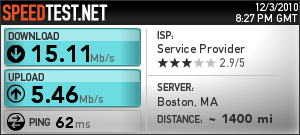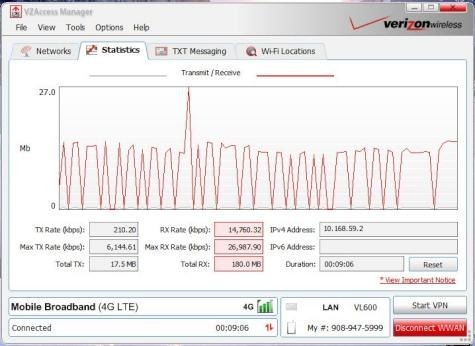Verizon’s new 4G service is live and it’s fast. I’ve been testing out one of the two devices that’ll be available this Sunday, the $99 LG VL600 USB modem, and I can honestly say that it blurs the line between lower-tier home broadband plans from the likes of Comcast and Time Warner.
Now keep in mind that nobody’s really on Verizon’s 4G network yet. Here in the Boston area, it’s basically yours truly, a handful of Verizon employees (I’d assume), and any other tech writers who may have gotten an early device. (More on Techland: How To: Recycle Your Old Gadgets)
 That being said, speed tests pegged maximum download rates at upwards of 20 megabits per second and maximum upload rates at around 6 megabits per second. For most web surfing, my download speeds generally clocked in at between 10 and 12 megabits per second, with upload speeds around 2 megabits per second.
That being said, speed tests pegged maximum download rates at upwards of 20 megabits per second and maximum upload rates at around 6 megabits per second. For most web surfing, my download speeds generally clocked in at between 10 and 12 megabits per second, with upload speeds around 2 megabits per second.
For comparison, Comcast’s “Performance” home broadband plan here in the Boston area runs $45 per month and promises download speeds of up to 12 megabits per second, with upload speeds of up to 2 megabits per second.
So a single person with one computer could conceivably go with Verizon over Comcast for roughly the same monthly price and could take the connection anywhere there’s a Verizon signal.
The problem is that Verizon’s 4G data is capped at 5 or 10 gigabytes of usage per month, depending on the plan ($50 per month and $80 per month, respectively). This is a really odd move, as competing 4G providers aren’t capping usage at all. (More on Techland: Verizon to Pay $77 Million in FCC ‘Mystery Fees’ Investigation)
Take Sprint, for instance. Its 4G plan costs $50 per month and provides for unlimited usage. Add another $10 per month and you can get unlimited 4G data along with 5 gigabytes of 3G data. People are used to 3G data being capped, but the promise of 4G has traditionally been that the speeds are so fast and the pipelines are so big that nothing needs to be metered.
Verizon’s setup process and software also leave a whole lot to be desired. Though the device I tested is a USB modem and could theoretically hold files like a standard USB thumb drive, the installation software comes on a CD (remember those?) or has to be downloaded from the internet first.
By comparison, the 3G USB modem I have from Virgin Mobile contains all of the necessary software loaded right onto the modem itself. Plug it in and it installs the software and connects you to the activation site. (More on Techland: AT&T, T-Mobile and Verizon Want Phones to Replace Credit Cards)
All I could picture was someone at the airport buying this thing out of one of those kiosks and trying to get it to work with a netbook. You have to call an 800 number to activate it, then install the software from the CD (hope you have a CD drive) or download it (hope you have an internet connection) before you can get online. And the software looks like it’s from last decade.

The connection button says “Connect WWAN” and “Disconnect WWAN.”
Luckily once everything’s up and running, it’s very fast and very stable. And even Sprint’s much more affordable (and unlimited) 4G service promises “average download speeds of 3-6 Mbps,” whereas Verizon averaged double that, with a peak download speed of 27 megabits per second at one point.
So if it’s speed you’re after and you can stomach the expensive, capped monthly service plans, Verizon’s 4G offering doesn’t disappoint. If you’re looking for something more affordable, though, there are other options.
More on Techland:
Verizon Launching Fast 4G Mobile Data Service Next Week

